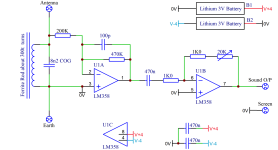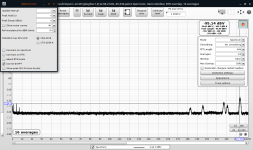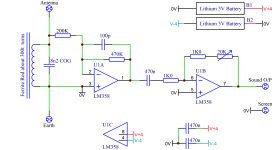Proposed Tuned Sound Amplifier/Receiver for the VLF Christmas Eve transmission from SAQ, Grimeton, Sweden

The Ferrite Rod is wound to resonate with the 8n2 COG capacitor at 17.2 KHz, U1A provides an initial gain of x2 with an input resistance of 200K. U1B gives a variable gain from x1 to x21. Power is from two Lithium batteries. No on/off switch is shown but can be included. The Antenna and Earth (Ground Earth) connections are optional. Sound output and screen to be connected to Mobile Phone, Tab or Laptop PC by 3.5mm Jack Plug.
The Ferrite Rod is wound to resonate with the 8n2 COG capacitor at 17.2 KHz, U1A provides an initial gain of x2 with an input resistance of 200K. U1B gives a variable gain from x1 to x21. Power is from two Lithium batteries. No on/off switch is shown but can be included. The Antenna and Earth (Ground Earth) connections are optional. Sound output and screen to be connected to Mobile Phone, Tab or Laptop PC by 3.5mm Jack Plug.
Attachments
The nearest to SAQ station here is at 19.8 KHz, according to https://en.wikipedia.org/wiki/Very_low_frequency Australia. It's likely, coverage is global, so a good test station.

Low noise is pointless the signal to noise ratio of the received signal is very bad. Its affected by global lightning storms that never stop. Resonating and narrow bandpass filtering around 17200 Hz is my only way of removing noise.
The efficiency of a ferrite rod aerial at low frequencies is also very bad. In fact, as far as I know, the usual way to design a ferrite rod receiver with a decent sensitivity is:
1. Look up the atmospheric noise levels at the frequency of interest and calculate what efficiency the ferrite rod aerial needs to have to ensure that the received atmospheric noise is still a couple of times larger than its own thermal noise
2. Design the aerial to have that efficiency
3. Design the rest of the receiver to have an equivalent input noise of the order of the thermal noise of the aerial or less
If you did a calculation or experiment showing that your amplifier is good enough, just say so, instead of shouting RUBBISH and mentioning battery chargers.
Regarding crossover distortion, you will get it when in the negative peaks, an LM358 output has to draw more than 50 uA (could also be 12 uA due to exemplaric spread). I don't see how you can exclude that possibility. A resistor to the negative supply can fix it, if needed.
By the way, the simplest way I can think of to interface a ferrite rod to a computer would be to connect the ferrite rod and capacitor between gate and source of an N-channel JFET with an IDSS of about 0.5 mA, like those that are used in ordinary two-pin electret microphone capsules, and to connect drain and source to a microphone input with plug-in power. No idea if it is good enough to be usable, though.
Do the 300 turns need to be on the same ferrite former or could I use multiple AM band pre wound ferrites in series?
You can put as many MW ferrite sets in series as physically possible, there are MW DXers having done so with success. Sensitivity will ~increase accordingly. It might take many rods to realize total inductance of ~10 mH.
For those needing extra inspiration:
https://www.peditio.net/utility/pdf/Large_Ferrite_Loop_Antennas.pdf
https://www.peditio.net/utility/pdf/Large_Ferrite_Loop_Antennas.pdf
Got interested whether I could detect any VLF stations with a simple ferrite antenna. The attached plot shows some peaks that I attribute to Skelton, Cumbria/UK (22.1kHz), Antharn, Cumbria/UK (19.58kHz) and the biggest peak from Rhauderfehn, Germany. The ferrite core pointed north-south resulting in an east-west sensitivity maximum.
Attachments
I am just curious about this VLF. I found vlf.it RADIO WAVES below 22 kHz which has various projects about antennas and circuits.
http://www.vlf.it/poggi2/audioantenna.html
http://www.vlf.it/poggi2/audioantenna.html
The noise floor in VLF is far-far above resistor thermal noise. You have both distant lightning and smps noise everywhere
I do like your circuit of post #34 the design and the style of it. My concern is sampling mixing - why not offer a simplified version (just the front end) that can feed the unprocessed but narrow band 17.2 kHz directly into a phone or laptop 3.5mm sound input. All the processing people want can be done in software. Keep the design floating by using batteries. The design need not be balanced as long as everything is floating, floating will give balance. The mobile phone or laptop should also be floating.As Xmas eve happens in a few days and SAQ receivers have to be constructed and tested, this circuit diagram with sim might speed up the process.
The sound recording should be done at 48kB/s into a wav file ie not mp3.
The discussion as regards choice of OpAmp is rendered trivial simply by using single OpAmps rather than dual or quad and 8 pin DIL sockets, people can then fit what OpAmps they like within design constraints.
The main objective here is to receive Grimeton SAK in the spirit of Christmas and international peace, rather than us members abrading about OpAmp choices.
The Ferrite Rod (200mm x 12mm) looks good with about 300 turns resonated with 8n2 COG capacitor, expect there will be some small amount of "frequency wobble or mispositioning" of the generated carrier (Grimeton SAQ not exactly synchronised to atomic clock 😂).
The overall Q (resonance Quality factor) of the hardware and software can be very high (especially at the front end) because the Morse code signal does not have any bandwidth, the carrier at 17200 Hz is either present or absent so no bandwidth apart from whatever atmospheric effects.
@bucks bunny @SAQ Grimeton
@Aridace
Last edited:
For those that haven't seen it, you should check out the operation of the alternator etc at SAQ Grimeton in the Youtube video linked to by Rich previously. It's absolutely fascinating!
I can't begin to imagine what it would cost to make such a setup nowadays. I take my hat off to the volunteers looking after this important piece of history.
I can't begin to imagine what it would cost to make such a setup nowadays. I take my hat off to the volunteers looking after this important piece of history.
Yes thanks here is the link to the 4th July video again, same link as given early on in this thread.
Yes here is the SAQ Grimeton Transmission, Alexander Sunday, July 4th 2021 - it is nearly 45minutes long, includes commentary and is very moving!
Here is the link to the Alexander Association:- Alexander Association Website
Here is the link to the SAQ transmission this Sunday morning (Christmas Eve) December 24th 2023:-
SAQ transmission scheduled for Christmas Eve morning, December 24th 2023
07:30 GMT Startup and tuning of the Alexanderson Alternator SAQ Grimeton, Sweden
08:00 GMT Transmission of a message from SAQ Grimeton, Sweden
-
Yes here is the SAQ Grimeton Transmission, Alexander Sunday, July 4th 2021 - it is nearly 45minutes long, includes commentary and is very moving!
Here is the link to the Alexander Association:- Alexander Association Website
Here is the link to the SAQ transmission this Sunday morning (Christmas Eve) December 24th 2023:-
SAQ transmission scheduled for Christmas Eve morning, December 24th 2023
07:30 GMT Startup and tuning of the Alexanderson Alternator SAQ Grimeton, Sweden
08:00 GMT Transmission of a message from SAQ Grimeton, Sweden
-
Last edited:
As Xmas eve happens in a few days and SAQ receivers have to be constructed and tested, this circuit diagram with sim might speed up the process.
I do like your circuit of post #34 the design and the style of it. My concern is sampling mixing - why not offer a simplified version (just the front end) that can feed the unprocessed but narrow band 17.2 kHz directly into a phone or laptop 3.5mm sound input. All the processing people want can be done in software. Keep the design floating by using batteries. The design need not be balanced as long as everything is floating, floating will give balance. The mobile phone or laptop should also be floating.
The sound recording should be done at 48kB/s into a wav file ie not mp3.
The discussion as regards choice of OpAmp is rendered trivial simply by using single OpAmps rather than dual or quad and 8 pin DIL sockets, people can then fit what OpAmps they like within design constraints.
The main objective here is to receive Grimeton SAK in the spirit of Christmas and international peace, rather than us members abrading about OpAmp choices.
The Ferrite Rod (200mm x 12mm) looks good with about 300 turns resonated with 8n2 COG capacitor, expect there will be some small amount of "frequency wobble or mispositioning" of the generated carrier (Grimeton SAQ not exactly synchronised to atomic clock 😂).
The overall Q (resonance Quality factor) of the hardware and software can be very high (especially at the front end) because the Morse code signal does not have any bandwidth, the carrier at 17200 Hz is either present or absent so no bandwidth apart from whatever atmospheric effects.
@bucks bunny @SAQ Grimeton
@Aridace
-
Simple LF Receiver for 17200 Hz (Ferrite Rod 200mm x 12mm, wind to resonate at 17200 Hz approx 300+ turns)

Attachments
Last edited:
A major reason why I presented a complete receiver is the amount of EMI in the average urban household. With a mobile RX it's possible to find locations with low enough EMI for good reception and the sound can be recorded with a phone and later processed with a PC for morse decoding. BTW my loop antenna is located at ~40m from the house and on the SDR some of the EMI still is visible. I had to use a transformer to match the 75 coax to the 50 ohm SDR. SWR has to be as close to 1 as possible, as any deviation results in unwanted signal pickup. Ground is a nonissue here, any ground rod works just as a buried part of a dipole. Not exactly the usual textbook stuff.
All good in Cardiff apart from a little road works, traffic delays and the occasional storm lol Hope all good in Perth - I have not been that far WestMy wife's from Cardiff and I've been there a few times now and still have family and friends there. I'm going to read up on this pronto. I wonder if I might have a crack at hearing this
Oh yes and the Welsh Assembly First Minister has recently resigned - presumably so they can get a new FM up and running before the next UK wide General Election that must be held before January 2025. 👍
Last edited:
With a mobile RX it's possible to find locations with low enough EMI for good reception and the sound can be recorded with a phone and later processed with a PC for morse decoding.
Strong bandpass filtering with a narrow pass band will reduce noise. Hence resonant Ferrite Rod front end at 17200 Hz, low pass and high pass filter in hardware and more bandpass filtering with a narrow pass band in software app. With this kind of Morse code the carrier is either on or off - no sidebands etc so bandpass filter can be very strong/sharp - only limitation is 1. Variation of the carrier frequency transmitted by SAQ Grimeton. 2. Any possible atmospheric conditions that can somehow alter carrier frequency ?? Software can also apply AGC to the carrier to stabilise its amplitude prior to processing the Morse. Once other frequencies are mixed into the clean fundamental carrier then situation becomes more complicated to deal with in software because of sidebands, bandwidth, aliasing etc.
richgwilliams CQ 72 73
- Home
- Amplifiers
- Solid State
- Tuned Sound Amplifier/Receiver for the VLF Christmas Eve transmission from SAQ, Grimeton, Sweden


